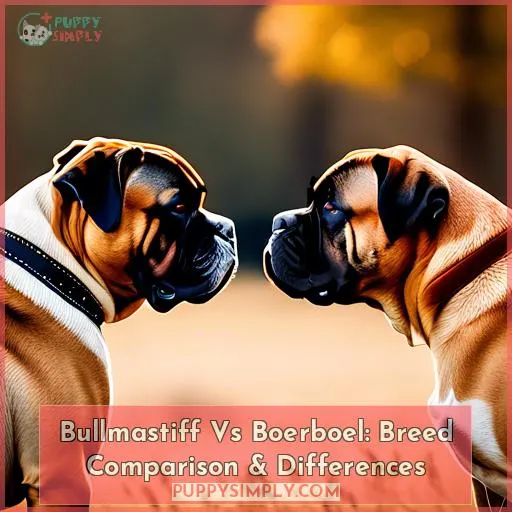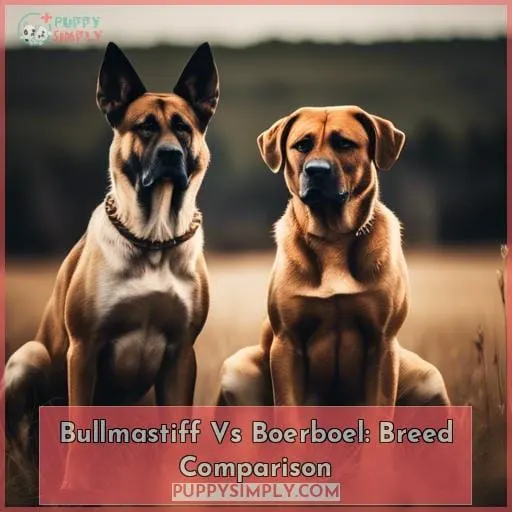This site is supported by our readers. We may earn a commission, at no cost to you, if you purchase through links.

Table Of Contents
- Key Takeaways
- Bullmastiff Vs Boerboel: Breed Comparison
- History and Origins
- Size and Appearance
- Temperament and Personality Traits
- Exercise and Energy Levels
- Training and Socialization Needs
- Health Risks and Common Issues
- Nutrition and Dietary Needs
- Grooming and Coat Maintenance
- Considerations for Choosing Between Bullmastiff and Boerboel
- Frequently Asked Questions (FAQs)
- Conclusion
Key Takeaways
- Boerboels are larger and more muscular compared to Bullmastiffs.
- Both breeds have similar facial features and coat colors, including black masks and fawn tones.
- Bullmastiffs have longer tails than Boerboels.
- Boerboels have a more intense protective instinct, while Bullmastiffs are generally more obedient.
Bullmastiff Vs Boerboel: Breed Comparison
When comparing Bullmastiffs and Boerboels, there are several key points to consider.
In terms of appearance, the Boerboel is larger and heavier than the Bullmastiff.
Temperament-wise, both breeds are protective but differ in intensity; Boerboels tend to be more intense while Bullmastiffs are generally more obedient.
Exercise needs also vary with Boerboels requiring more activity compared to the lower energy levels of Bullmastiffs.
Training methods for these intelligent breeds should focus on positive reinforcement, while health concerns such as hip dysplasia should be monitored closely in both breeds.
Appearance
When comparing the appearance of Bullmastiffs and Boerboels, it’s important to note distinct differences in their physical characteristics.
In terms of size, Boerboels are larger and heavier than Bullmastiffs. They’ve a more muscular build with deep chests, while both breeds share similar facial features like black masks and dark round eyes.
Coat colors for both include fawn tones, brindle jackets, and red hues. Additionally, Bullmastiffs have longer tails compared to Boerboels.
Temperament
To compare the temperaments of Bullmastiffs and Boerboels, it’s important to consider their distinct characteristics.
Both breeds have protective instincts and are known for their loyalty to family. However, there are some differences in their temperament.
Boerboels tend to be more intense and independent due to their working background, while Bullmastiffs are generally more obedient and less intense.
Training challenges may arise with both breeds due to their dominant nature, but proper socialization can help manage these traits effectively.
Exercise
Get ready to keep up with the exercise needs of both breeds, as Bullmastiffs and Boerboels require regular physical activity to stay happy and healthy.
Boerboels have a higher energy level and need around 60 minutes of exercise per day, while Bullmastiffs require approximately 45 minutes.
Both breeds are playful, energetic, and intelligent. Engaging in activities that stimulate their minds along with physical exertion will help maintain their overall well-being.
Training
If you’re considering training a Bullmastiff or Boerboel, it’s important to understand the differences in their trainability and temperament.
Both breeds require advanced training techniques due to their strong guarding instincts.
Socialization challenges may arise with other dogs and small animals, so behavioral consistency is crucial.
Positive reinforcement methods are highly recommended for both breeds to ensure effective training outcomes.
Proper management of their natural guarding instincts is essential for a well-trained Bullmastiff or Boerboel.
Health
In terms of health, both the Bullmastiff and Boerboel breeds have specific considerations to keep in mind.
Health considerations for these mastiff breeds include:
- Genetic predispositions such as hip and elbow dysplasia,
- Eye concerns like entropion and progressive retinal atrophy,
- As well as heart issues and thyroid abnormalities in Bullmastiffs.
Proper nutrition with high-quality kibble is essential to prevent obesity.
Regular exercise impacts their overall wellbeing.
It’s important to monitor their health closely and seek veterinary attention when needed for a longer lifespan.
Nutrition
When it comes to feeding your Bullmastiff or Boerboel, proper nutrition is essential for their overall health and wellbeing. Both breeds have specific nutritional needs that should be met through balanced diets.
Feeding practices should take into consideration the size and activity level of these bull-type dogs. It’s important to provide high-quality kibble in appropriate portions to prevent obesity and other health issues such as gastric torsion.
Understanding the unique nutrition requirements of your independent dog will contribute to their long-term health and happiness.
Grooming
To maintain their sleek and short coats, both the Bullmastiff and Boerboel require regular grooming.
Brushing is essential to keep their coats healthy and free from matting. Use a grooming tool suitable for their coat type, such as a slicker brush or rubber curry comb.
Weekly brushing will help remove loose hair and distribute natural oils throughout the coat.
Additionally, bathing should be done every 8-12 weeks using a gentle doggy shampoo to prevent drying out the skin.
Don’t forget to check for any signs of skin irritation or infections during grooming sessions.
Puppy Price
When considering the puppy price for Bullmastiff and Boerboel breeds, it’s important to note that both breeds can vary in cost depending on factors such as:
- Lineage
- Breeder reputation
- Geographical location
Puppy price analysis reveals that Boerboel puppies are generally priced higher compared to Bullmastiffs due to their rarity and demand. However, it’s crucial to prioritize ethical purchases by choosing a reputable breeder who prioritizes the health and well-being of their dogs over profit.
Budget considerations should be taken into account when deciding on which breed is right for you. Stay informed about market trends and seek recommendations from experienced breeders before making your purchase decision.
History and Origins
Let’s delve into the rich history and origins of both the Bullmastiff and Boerboel breeds with an exploration into their developmental journeys over time.
The bullmastiffs have a captivating story that begins in England where they served as loyal night dogs for gamekeepers tasked with protecting valuable estates from poachers under cover of darkness during long nights patrolling vast grounds across English countryside.
While later evolving further south by becoming crucial guardians within diamond-rich territories known as ‘The Big Hole’ located deep within Kimberly minefields situated throughout Southern-Africa.
Conversely, boerbulls come alive closer to home originating closeby neighboring regions bordering Namibia, Botswana, Zimbabwe, Mozambique, Swaziland, and Lesotho; eventually establishing themselves firmly rooted and deeply ingrained within local indigenous farming communities many decades ago.
Integrating seamlessly alongside native livestock species achieving symbiotic relationships benefiting all parties involved thus creating harmony and balance between nature and man alike. Forging a path forward together, a united front against common adversaries and challenging times.
Collectively pursuing a shared vision of prosperity, peace, happiness, and wellbeing for future generations unborn. Ensuring continued survival, thriving existence, and success overcoming prevailing adverse conditions in the present world around us.
Bearing witness to change in real-time, witnessing firsthand the hard work, dedication, commitment, love, and sacrifice put forth by dedicated breeders, passionate owners, and enthusiasts on a global scale.
Working tirelessly behind the scenes furthering the interests of dogs, breeds, and sciences. Continuously evolving for the betterment, preservation, and protection of enhancing the overall welfare of these noble creatures.
Size and Appearance
When comparing the size and appearance of Bullmastiffs and Boerboels, there are several notable differences.
Firstly, in terms of coat colors, both breeds have similar tones such as fawn and red, along with a black mask and brindle jacket. However, Boerboels also come in brown and wheaten colors while Bullmastiffs can be apricot or white.
Additionally, when it comes to their tails and muzzles, Bullmastiffs typically have longer tails compared to Boerboels who’ve flatter muzzles.
Coat Colors
Now let’s explore the coat colors and size differences between Bullmastiffs and Boerboels.
When it comes to coat colors, both breeds exhibit a range of beautiful variations.
- Fawn Variations: Both Bullmastiffs and Boerboels can have fawn-colored coats in different shades.
- Brindle Patterns: Both breeds also display brindle patterns, with stripes or streaks of darker color on their base coat.
- Coat Genetics: The genetics behind these coat colors are fascinating, as they contribute to the unique appearance of each breed.
- Red Tone Diversity and Black Mask Impact: Additionally, both Bullmastiffs and Boerboels may have red tones in their coats along with a distinctive black mask that adds character to their overall appearance.
Tail and Muzzle Differences
To distinguish between the Bullmastiff and Boerboel breeds, one noticeable difference lies in their tail and muzzle characteristics.
- The Bullmastiff has a longer, thicker tail compared to the Boerboel.
- In terms of muzzle shape, the Boerboel has a flatter muzzle while the Bullmastiff’s is slightly more pronounced.
Both breeds have expressive ears that drop down in a triangular shape.
When it comes to head structure and facial features, both exhibit square-shaped heads with big fleshy noses and dark round eyes.
Temperament and Personality Traits
When comparing the temperament and personality traits of Bullmastiffs and Boerboels, it’s important to note that both breeds have strong protective instincts.
They’re known for their loyalty towards their families and will go to great lengths to keep them safe.
Additionally, both breeds are generally good with humans, but caution should be exercised around other dogs or small animals due to potential aggression tendencies.
Protective Instincts
Understand the protective instincts of both breeds to determine which one suits your needs.
When comparing Bullmastiffs and Boerboels, their temperament and personality traits play a significant role.
- Protective Instincts: Both breeds have strong protective instincts towards their families.
- Training Techniques: Intense training is required for both breeds, making them better suited for experienced dog owners.
- Socialization Challenges: Proper socialization is crucial due to potential aggression towards other dogs or small animals.
Family-Oriented
You’ll find both breeds are devoted and affectionate with their families, though the Boerboel tends to bond more intensely to one person while the Bullmastiff aims to please the entire household.
Both breeds exhibit strong guardian instincts and can be protective of their family members.
However, training challenges may arise due to their size considerations.
It’s important for owners of both breeds to establish clear leadership and provide consistent training from an early age in order to foster positive family dynamics.
Exercise and Energy Levels
When it comes to exercise and energy levels, there’s a clear distinction between the Boerboel and Bullmastiff breeds.
The Boerboel has a high energy level, requiring at least 60 minutes of exercise per day to meet its physical needs.
On the other hand, the Bullmastiff has a low energy level and can be satisfied with approximately 45 minutes of daily activity.
It’s important to consider these differences when choosing which breed would best fit your lifestyle and ability to provide adequate exercise for your furry companion.
Boerboel’s High Energy Level
For those considering a Boerboel, it’s important to be aware of their high energy level and exercise needs.
- High-energy activities: Boerboels thrive on vigorous exercises such as long walks, jogging, or playing fetch.
- Exercise varieties: To keep them mentally stimulated, consider incorporating agility training or puzzle toys into their exercise routine.
- Playtime strategies: Engage in interactive play sessions with your Boerboel to channel their energy and strengthen the bond between you.
Proper management of your Boerboel’s high energy levels will contribute to a happy and well-balanced companion.
Bullmastiff’s Low Energy Level
To continue the comparison between Bullmastiffs and Boerboels, let’s delve into the topic of exercise and energy levels in Bullmastiffs.
Unlike their energetic counterparts, Bullmastiffs have a low energy level that makes them perfect for those seeking laid-back companionship. These giant breeds are known for being lazy couch potatoes who prefer leisurely pet care routines.
With proper energy management and exercise strategies, they can lead happy and healthy lives while enjoying a more relaxed lifestyle compared to high-intensity breeds.
Training and Socialization Needs
When it comes to training and socialization needs, there are some key differences between Bullmastiffs and Boerboels to consider.
- Bullmastiffs tend to be more obedient, while Boerboels may exhibit more stubbornness due to their independent farm dog heritage.
- However, both breeds need extensive socialization and positive reinforcement training starting at a very young age to properly manage their protective instincts and prevent unwarranted aggression.
Dominance and Guarding Instincts
As you’re aware from managing their energy levels, you’ll need to properly address the dominance and guarding instincts of these protective breeds through obedient training and early socialization.
To ensure behavioral balance in Bullmastiffs and Boerboels, consider the following:
- Dominance Training: Establish yourself as a strong leader through consistent training methods.
- Guarding Instincts: Channel their natural protective instincts into controlled behavior.
- Behavioral Balance: Strive for a well-rounded temperament that balances protectiveness with sociability.
- Protective Training: Teach them when it’s appropriate to be alert and guard against potential threats.
By focusing on dominance training, guarding instincts management, achieving behavioral balance, and implementing protective training techniques during obedience sessions will help shape your Bullmastiff or Boerboel into an outstanding companion who can provide both security and companionship.
Obedience and Stubbornness
When training your bullmastiff or boerboel, you’ll find the boerboel’s cooperative farm background makes them less stubborn than the bullmastiff, who was bred more for looks.
Overcome bullmastiff obedience challenges with positive reinforcement training techniques focused on stubbornness management and balancing temperament.
Consistency helps achieve behavioral goals for both breeds.
Health Risks and Common Issues
When comparing the health risks and common issues between Bullmastiffs and Boerboels, it’s important to note that:
- Bullmastiffs have an average health rating while Boerboels tend to have above-average health.
- Both breeds are prone to hip and elbow dysplasia, as well as various eye concerns.
- Bullmastiffs may also experience heart issues and thyroid abnormalities.
It’s crucial for potential owners of either breed to be aware of these potential health risks and take necessary precautions for their dog’s well-being.
Bullmastiff’s Average Health
Take note of the Bullmastiff’s average health and be aware of potential health risks and common issues.
- Genetic predispositions: Bullmastiffs are prone to hip dysplasia, a condition where the hip joint doesn’t develop properly, causing pain and mobility issues.
- Obesity risk: Due to their low energy levels, Bullmastiffs can easily become overweight if not provided with proper exercise and nutrition.
- Health maintenance: Regular vet check-ups, preventive care measures such as vaccinations and parasite control, along with a balanced diet will contribute to their overall well-being.
Remember that understanding these longevity factors is essential in ensuring your Bullmastiff’s optimal health throughout its lifespan.
Boerboel’s Above Average Health
To ensure the overall well-being of your Boerboel, it’s important to be aware of their above-average health and potential risks.
With proper nutrition and exercise, Boerboels enjoy greater longevity than Bullmastiffs, averaging 9-11 years. However, hip and elbow dysplasia may occur. Schedule preventative screening to mitigate these concerns.
Overall, Boerboels have fewer health issues, but require diligent care and activity to reach their full lifespan potential.
Nutrition and Dietary Needs
To ensure optimal health and well-being, both the Bullmastiff and Boerboel require proper nutrition and a balanced diet.
As giant breeds, these dogs have specific dietary needs that must be met to support their growth, maintain a healthy weight, and prevent obesity.
Providing them with high-quality kibble formulated for giant breed diets is essential.
These specialized formulas are designed to meet the unique nutritional requirements of large dogs by providing adequate levels of protein, fat, carbohydrates, vitamins,and minerals while controlling calorie intake.
Additionally,it’s important to consider digestive health when choosing their food.
Having a balanced diet promotes good digestion,reduces gastrointestinal issues,and supports overall well-being.
Dietary supplements may also be beneficial in supporting joint health or addressing specific conditions;however,it’s crucial to consult with your veterinarian before adding any supplements.
Feeding guidelines typically recommend 3-4 cups per day for Bullmastiffsand 5-6 cups per day for Boerboels based on weight,height,and activity level.
Carefully monitoring portion sizes is key in preventing overfeeding which can leadto obesity-related health problems.
The cost of puppy food should also be taken into consideration during budget planning.
Prioritizing your dog’s nutritional balance will contribute greatly towards maintainingtheir long-term vitality.
Grooming and Coat Maintenance
Maintaining the grooming and coat of your Bullmastiff or Boerboel is essential to keep them looking their best.
Both breeds have short, sleek coats that require weekly brushing to remove loose hair and prevent matting.
Bathing should be done every 8 to 12 weeks using a gentle doggy shampoo formulated for sensitive skin. It’s important to avoid over-bathing as it can strip the natural oils from their coats, leading to dryness and irritation.
Additionally, be cautious of backstreet breeders who may neglect proper grooming practices in their dogs.
By prioritizing grooming and coat maintenance, you can ensure that your Bullmastiff or Boerboel stays clean, comfortable, and free from excessive shedding while minimizing any potential eye concerns associated with these breeds.
Considerations for Choosing Between Bullmastiff and Boerboel
When choosing between a Bullmastiff and a Boerboel, carefully consider their differences in:
- Temperament
- Behavior
- Exercise needs
- Energy levels
While both breeds are loyal and protective, the Boerboel tends to be more intense and demanding, requiring experienced handling, whereas the calmer Bullmastiff may better suit a family seeking an affectionate yet low-maintenance companion.
Keep in mind that early socialization and positive reinforcement training are essential for managing the natural protectiveness in these breeds.
Temperament and Behavior
When comparing Bullmastiff and Boerboel temperaments, you’ll be evaluating their:
- Intensity of protectiveness
- Ability to distinguish threats
- Compatibility with children or other pets
Before deciding which breed best suits your family’s needs.
Both breeds have a strong protective instinct but differ in intensity. Training methods should focus on positive reinforcement for both breeds due to their cooperative nature. Socialization techniques are crucial to ensure proper behavior around people and animals.
Handling differences include the size and strength of Boerboels, requiring a firm handler for control.
Exercise and Energy
If you’re considering whether a Bullmastiff or Boerboel is the right breed for you, it’s important to take into account their exercise and energy levels.
Boerboels have high energy levels and require plenty of physical activity to expend that energy. They enjoy playtime preferences such as interactive games, long walks, and even swimming sessions.
On the other hand, Bullmastiffs have low energy levels and prefer shorter exercise routines with moderate intensity. It’s crucial to adapt their activities accordingly for proper energy management.
Frequently Asked Questions (FAQs)
Are Bullmastiffs and Boerboels good with children?
Both Bullmastiffs and Boerboels can be good with children if properly socialized and trained from a young age.
However, supervision is essential as their large size coupled with protective instincts mean they could accidentally hurt kids.
Careful management of these loyal guard dogs will ensure happy families.
Which breed is more suitable for first-time dog owners?
I can’t recommend either breed for first-time owners. Both require experienced handlers fully committed to proper socialization, training, and meeting their considerable needs.
Do Bullmastiffs and Boerboels get along well with other pets?
Unfortunately, neither breed tends to get along well with other pets. Both Bullmastiffs and Boerboels exhibit strong protective instincts toward their families.
You’ll need to be extremely cautious when introducing them to other animals. Proper training and socialization from an early age are essential for managing their dominance and potential aggression.
Are Bullmastiffs and Boerboels prone to separation anxiety?
You’re quite right, separation anxiety can be an issue for both breeds if not properly socialized.
Providing plenty of positive interactions, never isolating pups, and making sure they feel secure helps prevent this.
Firm leadership and meeting their needs is key.
Can Bullmastiffs and Boerboels live in apartments or small spaces?
You can raise Bullmastiffs and Boerboels in apartments or smaller spaces if you’re committed to exercising them regularly and managing their protective instincts.
Focus on early and consistent training around other people and animals, as well as basic obedience.
Strong leadership skills are a must.
Conclusion
To conclude, when comparing the Bullmastiff and Boerboel breeds, there are several key differences to consider.
- While both breeds are powerful and protective, the Bullmastiff tends to have a lower energy level and is more suited for families seeking a calmer companion.
- On the other hand, the Boerboel is known for its high energy and requires more exercise.
- Additionally, the Boerboel has a reputation for above-average health, whereas the Bullmastiff has average health.
Ultimately, the decision between these two breeds should be based on factors such as temperament, energy level, and exercise needs.
















